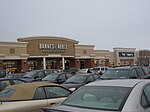Pioneer Valley Chinese Immersion Charter School
Charter high schools in MassachusettsCharter middle schools in MassachusettsChinese-American culture in MassachusettsChinese-language educationHadley, Massachusetts ... and 3 more
International Baccalaureate schools in MassachusettsPublic elementary schools in MassachusettsSchools in Hampshire County, Massachusetts
The Pioneer Valley Chinese Immersion Charter School (simplified Chinese: 先锋中英双语学校; pinyin: Xiānfēng Zhōng-Yīng Shuāngyǔ Xuéxiào), abbreviated to PVCICS, is a public Charter school in Hadley, Massachusetts. Founded in February 2007, PVCICS offers an immersion program that teaches Chinese Language Arts and culture in addition to a regular curriculum. PVCICS' goals are to graduate students with excellent scholarship, high proficiency in Mandarin Chinese and English, plus sensitivity to multiple cultures. PVCICS serves the Pioneer Valley region.
Excerpt from the Wikipedia article Pioneer Valley Chinese Immersion Charter School (License: CC BY-SA 3.0, Authors).Pioneer Valley Chinese Immersion Charter School
Russell Street,
Geographical coordinates (GPS) Address Phone number Website External links Nearby Places Show on map
Geographical coordinates (GPS)
| Latitude | Longitude |
|---|---|
| N 42.3529 ° | E -72.5582 ° |
Address
Pioneer Valley Chinese Immersion Charter School
Russell Street 317
01035
Massachusetts, United States
Open on Google Maps







